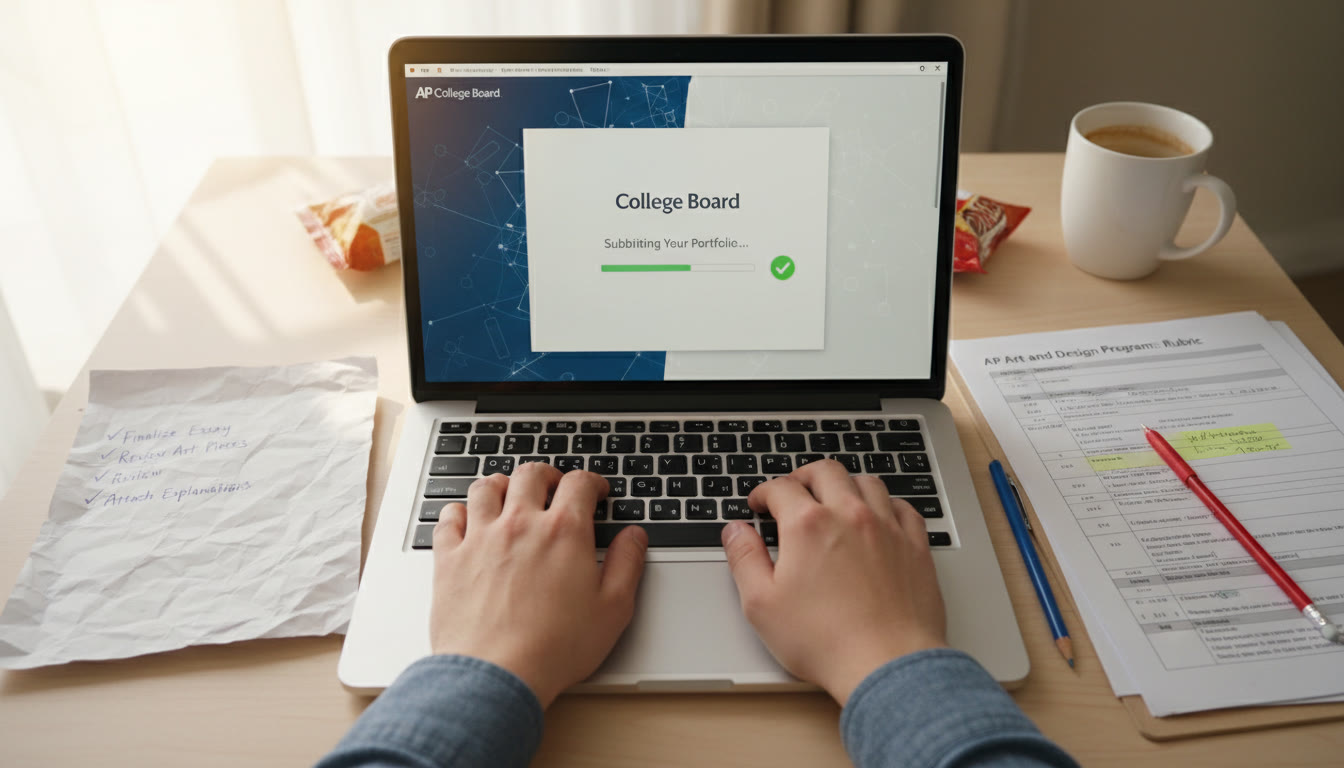What parents should know right up front
When your child says they have to build a “portfolio” for an AP class, it can sound mysterious—like an artful curio cabinet, a drawer of essays, or something their teacher conjures out of thin air. In reality, a portfolio in the AP world is a carefully organized body of work a student assembles to demonstrate skills, growth, and mastery of course goals. For Language and Arts APs—think AP Seminar, AP Research, and some performance-based elements in AP English or AP Art and Design—the portfolio is both evidence and argument: it shows what your student can do and why their work deserves a particular score.
Why this matters (beyond the grade)
Portfolios are more than an exam substitute. They teach planning, revision, reflection, and academic honesty. Colleges like portfolios because they reveal a student’s intellectual process, persistence, and capacity to create substantial, polished work. For a parent, understanding the portfolio means you can provide meaningful support—scheduling check-ins, helping prioritize tasks, and knowing when to step back so a teen can revise without pressure.

Which AP courses use portfolios and what “portfolio” looks like for each
Not all AP courses use portfolios. Some do a traditional timed exam; others require submissions of performance tasks. For Language and Arts fields, the portfolio concept most commonly appears in:
- AP Seminar — performance tasks and team projects stored as artifacts
- AP Research — a year-long academic paper, presentation, and reflective elements
- AP Art and Design — sustained investigation images, written evidence, and selected works submitted digitally
- AP English Language and Composition — while primarily exam-based, extended writing portfolios and drafts may be used in class and contribute to performance tasks or teacher scoring
Across these, “portfolio” can mean a collection of drafts and final pieces, multimedia files, annotated bibliographies, reflective commentaries, or recorded presentations. The key common thread: the portfolio chronicles process as well as product.
Understanding the AP Digital Portfolio (what to expect)
For several AP subjects, the College Board uses a secure, online portal called the AP Digital Portfolio. Students log in with their College Board credentials to upload files, images, PDFs, and other materials. Teachers and coordinators can view submission statuses, and in many cases, teachers upload or score materials there too. Deadlines are strict, so planning backward from submission dates is essential.
Practical features parents should know
- Single sign-on: Students use the same account they use for My AP or AP Classroom.
- Multiple file types: The platform accepts images, PDFs, audio/video files, and text documents—each course will specify allowed formats and size limits.
- Validation: The school’s AP coordinator often validates that a student’s work has been submitted for scoring—meaning an uploaded file is necessary but not always sufficient if the exam wasn’t ordered.
Deadlines, timelines, and how to pace the work
Deadlines for portfolio submission vary by course and year, and schools often have internal timelines too. That’s why a parent’s practical planning matters. Treat the process like a long-term project with milestones, and your teen will feel less frantic in the final weeks.
Sample timeline (academic year example)
| When | Milestone | Parent Role |
|---|---|---|
| August–October | Project ideas, research questions, initial drafts or sketches | Help establish weekly check-ins; encourage keeping drafts and notes |
| November–January | Develop and revise pieces; seek feedback; start digital organization | Support study environment; limit last-minute distractions |
| February–March | Finalize selections, proofread, photograph or digitize artwork | Provide time and resources for high-quality photos/scans |
| April | Final uploads to AP Digital Portfolio; teacher/counselor validation | Confirm upload and validation; celebrate completion |
Every family and school calendar looks different, so adapt this to your child’s specific course and teacher expectations.
How teachers and scoring work
Teachers guide students through the portfolio process, often scoring some components and helping with logistics. The College Board’s AP readers—trained scorers—evaluate submitted portfolios according to rubrics specific to each course. Those rubrics reward clarity of argument, evidence of revision, originality of inquiry, and technical competence (in writing, research methods, or artistic craft).
What scorers look for (plain-language translation)
- Clear purpose: Does the piece show a focused idea or question?
- Evidence: Are claims supported with appropriate sources, examples, or technique?
- Revision: Is there evidence the student revised and improved the work?
- Reflection: Does the student explain choices, challenges, and what they learned?
Concrete tips to help your child build a strong portfolio
Parents can be a practical backbone without doing the work for their teen. Here’s how to help effectively.
Organizational tactics
- Set up a single folder system (both physical and digital). Name files clearly with dates and version numbers.
- Encourage version control: draft_v1, draft_v2, final_03. This helps teachers and readers follow the revision arc.
- Back up everything. Use cloud storage plus a local copy.
Craft and reflection
- Teach the habit of reflection: after each draft, your teen should write a short note about what changed and why.
- Practice talking about work aloud. Many portfolios include presentations; being able to articulate process quickly is a skill.
- Prioritize quality over quantity. A smaller set of stronger pieces will usually score better than a large set of uneven work.
Technical prep (for art and multimedia)
- Good photographs make a huge difference for visual work—use natural light, neutral backgrounds, and a steady camera.
- Export audio/video with recommended codecs and inside size limits.
- Proof PDFs and check that fonts and margins are preserved when uploading.
How parents can support without overstepping
There’s a fine line between being a helpful advocate and doing the work. Your child’s voice must remain primary in every submission. Help with scheduling, resources, and encouragement. Offer feedback as questions rather than edits—ask “What do you want this piece to say?” instead of rewriting sentences.
What to avoid
- Don’t ghostwrite or heavily edit content—scorers look for authentic student work and process.
- Don’t delay uploads hoping for tiny improvements—technical deadlines are firm.
- Don’t pressure a teen to follow a “perfect” template—original thinking often earns more points.
Examples that clarify the difference between courses
Examples help demystify the abstract word “portfolio.” Here are three scenario sketches that show how portfolio expectations differ across Language and Arts APs.
Scenario A: The Research runner
Sophia is taking AP Research. Her portfolio is a 4,000–5,000 word academic paper, an oral presentation, and a reflective commentary. Her process included drafting questions, running a small study with ten participants, analyzing data, revising based on teacher feedback, and polishing citations. Her reflective write-up explains methodological choices and what she learned about ethics and sampling.
Scenario B: The Seminar solver
Marcus is in AP Seminar, which blends teamwork and individual argument. His portfolio includes an individual research-based essay, a team project with artifacts, and a presentation performance task. He kept annotated source cards and an evidence log showing how different pieces of research informed his argument—this process is as valuable as the final text.
Scenario C: The Visual storyteller
Elena is in AP 2-D Art and Design. Her Sustained Investigation includes 15 images documenting a theme across the year, written evidence describing her techniques and influences, and five selected works. She uploaded high-resolution photos with captions that explain materials and growth from early sketches to final pieces.
Common pitfalls and how to avoid them
Understanding common mistakes gives you a huge advantage as a parent-support system. Here are pitfalls students often fall into, with simple fixes.
- Procrastination: Break the project into weekly micro-goals. If your teen is overwhelmed, suggest two small tasks they can complete in 30 minutes.
- Poor documentation: Encourage a running log of sources, dates, and decisions. This is especially important for AP Research and Seminar.
- Technical errors on upload day: Run a tech rehearsal a week before the deadline—upload drafts as a test and confirm file integrity.
- Overly polished final without revision evidence: Keep drafts. Sometimes rubric points reward the documented process, not just the final sparkly product.
When tutoring or mentoring helps—and what to look for
Portfolios reward dedicated coaching. If your teen struggles with structure, research methods, time management, or presentation skills, targeted tutoring can make a measurable difference. Look for tutors who understand the AP rubrics, can model revision strategies, and help students own their voice rather than supply answers.
Why personalized tutoring works (and a natural fit for Sparkl’s approach)
Tailored, one-on-one tutoring brings focus: a tutor can spot gaps in argumentation, suggest better sources, run mock presentations, and tailor study plans to the student’s particular deadlines. Services like Sparkl’s personalized tutoring emphasize 1-on-1 guidance, tailored study plans, expert tutors, and AI-driven insights to track progress—helpful when a portfolio needs predictable progress and accountability. When used thoughtfully, tutoring empowers students to build evidence-based, reflective portfolios without losing their authentic voice.
How to assess progress: simple metrics parents can use
You don’t need to be an expert to measure momentum. Here are practical, parent-friendly checkpoints to track progress and keep stress low.
- Number of drafts completed each month
- Percentage of final portfolio items photographed or digitized
- Teacher feedback items addressed (a simple checklist works wonders)
- Time spent revising (track hours per week, not just days)
Preparing for the final upload
In the weeks before submission, shift from creation to quality control. Confirm file formats, double-check filenames, and perform a final rubric walk-through. Schedule a quiet block of time to upload materials so nothing gets rushed.
Final upload checklist
- Are all files correctly named and in the required formats?
- Have teacher-required reflections and captions been included?
- Has the student previewed each file after upload to confirm fidelity?
- Has the AP Coordinator validated the submission if required by the school?

After submission: debrief and learning for next time
Once the portfolio is submitted, encourage a decompression period followed by a reflective debrief. What worked? What felt rushed? Which strategies helped? This reflection turns one cycle into long-term academic skill, useful for college application portfolios and independent research.
Questions to guide the debrief
- What was the single most helpful habit you developed?
- Which feedback had the biggest impact on the work?
- If you could change one planning decision, what would it be?
Wrapping up: your role as the steady supporter
Parents don’t need to be content experts to make a meaningful contribution. Your strengths—scheduling, calm encouragement, logistical help, and knowing when to say “you’ve done enough”—are vital. By understanding what a portfolio is, what scorers value, and which practical steps reduce risk, you empower your teen to present their best work with confidence.
And remember: structured, personalized support—whether it’s regular check-ins or occasional expert help—can transform a fraught process into a learning milestone. If your child could benefit from guided revision, mock presentations, or accountability-focused study plans, consider tutoring that respects student authorship and builds academic independence. With thoughtful parenting and the right supports, the portfolio becomes proof not only of achievement, but of growth.
Final thought
Portfolios ask students to show who they are as thinkers, makers, and communicators. That’s a wonderful—if sometimes messy—opportunity. Stand beside your teen as a patient editor of life logistics, an empathetic listener for drafts, and a quiet cheerleader on submission day. The work they submit is temporary; the skills they build will last.























No Comments
Leave a comment Cancel